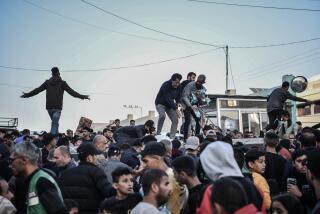Many Held at Guantanamo Not Likely Terrorists
WASHINGTON — The United States is holding dozens of prisoners at Guantanamo Bay who have no meaningful connection to Al Qaeda or the Taliban, and were sent to the maximum-security facility over the objections of intelligence officers in Afghanistan who had recommended them for release, according to military sources with direct knowledge of the matter.
At least 59 detainees -- nearly 10% of the prison population at the U.S. Navy base at Guantanamo Bay, Cuba -- were deemed to be of no intelligence value after repeated interrogations in Afghanistan. All were placed on “recommended for repatriation” lists well before they were transferred to Guantanamo Bay, a facility intended to hold the most hardened terrorists and Taliban suspects.
Dozens of the detainees are Afghan and Pakistani nationals described in classified intelligence reports as farmers, taxi drivers, cobblers and laborers. Some were low-level fighters conscripted by the Taliban in the weeks before the collapse of the ruling Afghan regime.
None of the 59 met U.S. screening criteria for determining which prisoners should be sent to Guantanamo Bay, military sources said. But all were transferred anyway, sources said, for reasons that continue to baffle and frustrate intelligence officers nearly a year after the first group of detainees arrived at the facility.
“There are a lot of guilty [people] in there,” said one officer, “but there’s a lot of farmers in there too.”
The sources’ accounts point to a previously undisclosed struggle within the military over the handling of the detainees. Even senior commanders were said to be troubled by the problems.
Maj. Gen. Michael E. Dunlavey, the operational commander at Guantanamo Bay until October, traveled to Afghanistan in the spring to complain that too many “Mickey Mouse” detainees were being sent to the already crowded facility, sources said.
One senior Army officer described Dunlavey’s visit as a “fact-finding” mission. But another who met with Dunlavey said the general’s purpose was more direct: “He came over to chew us out,” the officer said. Dunlavey, an Army reservist, declined to comment.
The sources blamed a host of problems, including flawed screening guidelines, policies that made it almost impossible to take prisoners off Guantanamo flight manifests and a pervasive fear of letting a valuable prisoner go free by mistake.
“No one wanted to be the guy who released the 21st hijacker,” one officer said.
While that concern remains a legitimate one, the fact that dozens of the detainees are still in custody a year or more after their capture has become a source of deep concern to military officers engaged in the war on terrorism around the globe.
Many fear that detaining innocents, and providing no legal mechanism for appeal, can only breed distrust and animosity toward the U.S. -- not only in the home countries and governments of the prisoners but also among the inmates.
“We’re basically condemning these guys to long-term imprisonment,” said a military official who was a senior interrogator at Guantanamo Bay.
“If they weren’t terrorists before, they certainly could be now.”
Moreover, he said, even amid the tight security there is significant indoctrination of prisoners by radical Islamists among them.
The Afghan and Pakistani governments have raised the issue with Washington. A Pakistani embassy official, who declined to be identified, said his government is convinced that many of the 58 Pakistanis known to be in custody “probably joined the Taliban but didn’t know how to spell Al Qaeda.”
Even some prisoners red-flagged by the screening guidelines were clearly of no intelligence value and should not have been sent, military intelligence sources said.
One prisoner was transferred because he was Arab by birth and had once fought for the Taliban, thereby meeting two key screening criteria. But before the war he had sustained such a massive head injury that he could utter little more than his name and was known by interrogators at Guantanamo Bay as “half-head Bob.”
“He had basically had a combat lobotomy,” the interrogator said. “Every [intelligence report] on him from Afghanistan said, ‘No value, no value, don’t send him.’ ”
Others were grabbed by Pakistani soldiers patrolling the Afghan border who collected bounties for prisoners, sources said. One such prisoner was captured at a restaurant near the border where he claimed to have lived and worked for 20 years.
“He had the mental capacity to put flatbread in an oven and that was the extent of his intellect,” the interrogator said. “He never got trained on a rifle, never got pressed into service. But he was Arab by birth so he was picked up and sent away.”
Pentagon officials declined to discuss individual cases, but insist that the U.S. has reasonable grounds for holding all the prisoners at Guantanamo Bay.
“All are considered enemy combatants lawfully detained in accordance with the law of armed conflict,” said Navy Lt. Cmdr. Barbara Burfeind, a spokeswoman for the U.S. Southern Command, which oversees operations at Guantanamo Bay.
Several senior military officers responsible for transfers of prisoners also defended their decisions.
“Everybody that was sent met the conditions that were sent down from our higher headquarters,” said Army Col. Michael T. Flynn, the top intelligence officer in Afghanistan when many of the detainees were transferred. “We were sending the right folks.”
According to classified Pentagon guidelines, Guantanamo Bay was meant to be a long-term detention facility for Al Qaeda operatives, Taliban leaders, “foreign” fighters and “any others who may pose a threat to U.S. interests, may have intelligence value, or may be of interest for U.S. prosecution.”
But from the beginning, prisoners who didn’t meet those criteria were sent, sources said. In some cases, military police seemed to have more influence over flight lists than intelligence officers, lobbying commanders to ship out troublesome detainees.
Other detainees seemed to get caught up in the military’s bureaucratic machinery. In many cases, low-value prisoners caught early in the war were placed at the bottom of prioritized lists. But as planeloads of prisoners were sent to Cuba, names at the bottoms of the lists drifted to the top, and some started showing up on flight manifests.
Once they appeared on the manifests, sources said, removing them proved almost impossible. Doing so required senior intelligence officers in Kuwait or Afghanistan to work through thickets of military red tape. It also required them to trust the judgment of junior intelligence officers, something they were loath to do given the stakes.
Through much of the war, the decisions were made far from the battlefield, by commanders in Kuwait or back in the United States. Intelligence officers in Afghanistan became increasingly dismayed at the number of low-level detainees on the manifests.
“We saw it as having huge potential for eroding public trust,” one officer said. In a conflict dependent on the cooperation of local Afghans, he said, “winning the hearts and minds was our greater concern.”
To call attention to the problem, some began circulating lists of prisoners they believed were being improperly placed on Guantanamo Bay flight manifests. The lists were seen by senior intelligence officers in Afghanistan, Kuwait and the United States.
One of the lists covers 49 Afghans and 10 Pakistanis who were being held at Kandahar Air Base until the Afghan facility was shut down in June, prompting their transfer to Guantanamo Bay, sources said.
The list describes detainees’ occupations, the circumstances of their captures, summaries of interrogations and alibis they provided. The prisoners range in age from 16 to 50, most with little or no education. None was deemed to have meaningful ties to Al Qaeda or the Taliban.
A typical entry describes a 30-year-old Afghan farmer captured by Afghan forces who “seemed most interested in stealing his car and money.”
Another describes a 22-year-old Afghan who sold firewood at a bus station in Konduz and was picked up by Northern Alliance forces while he and six others were traveling to Kabul, the Afghan capital.
“He answers all questions quickly and fully,” interrogators concluded. “His story is plausible and consistent, and there is no evidence that he has ever worked for or had any knowledge of the Taliban or Al Qaeda.”
Not all of the detainees’ stories are so tidy. Many admitted to being fighters for the Taliban, although often as low-level soldiers conscripted when they couldn’t afford payments required by the Taliban to avoid service -- often amounting to six months’ wages.
Among the Pakistanis on the list was a 16-year-old who traveled to Afghanistan at the start of the war to help the Taliban, but quickly had second thoughts and was captured by the Northern Alliance while trying to flee. “He showed no signs of deception,” interrogators noted. “He never fought for the Taliban.”
Another Pakistani, a 33-year-old taxi driver, was captured near Mazar-i-Sharif.
“The fact that the detainee’s taxi car broke down was a deciding factor for him to leave home and fight the Jihad,” according to his file.
“Detainee is a low-level fighter with no tactical intelligence. Recommend repatriation.”
These detainees would almost certainly have been repatriated had they not been captured early in the war, before screening systems were overhauled to make releasing low-level prisoners easier, sources said.
By midsummer, military officials took to withholding the names of new inmates from prison rosters until they could be evaluated. That way, they didn’t officially exist and, if deemed harmless, could be released before their names got caught up in the system.
“The same people who created this huge bureaucratic monster came up with a way to thwart it,” one Army interrogator said, “which is never enter people into the system.”
At Guantanamo Bay, the presence of dozens of low-value prisoners drained resources. The facility, known as Camp Delta, was also plagued by other problems.
A chronic shortage of military police meant interrogations were shut down at 9 p.m., sources said, denying interrogators the often effective tactic of subjecting detainees to marathon interview sessions.
There was also a confusing command structure that hampered information sharing. Guantanamo Bay was controlled by the U.S. Southern Command -- whose territory includes South America -- even though the war on Al Qaeda was principally the purview of the U.S. Central Command.
Intelligence reports often got tied up in transit between the two commands, sources said, sometimes delaying delivery for days. And intelligence officers at Southern Command who edited reports out of Guantanamo Bay knew far more about Colombian rebels than Al Qaeda terrorists.
The White House has classified prisoners at Guantanamo Bay as “enemy combatants,” a murky status in which detainees are not allowed hearings or legal representation.
In July, a federal judge considering a lawsuit filed on behalf of 14 Kuwaiti detainees ruled that prisoners at Guantanamo Bay have no right to appear in U.S. courts and can be held indefinitely.
In March, Defense Secretary Donald H. Rumsfeld acknowledged that the prison population at Guantanamo Bay went beyond the “hard-core” cases for which it was constructed.
“The first people who were brought down were the hardest of the hard-core,” Rumsfeld said. “Now it is a mix. They run pretty much across the spectrum.... Some may be transferred to other countries, some may be released, some may be held for the duration, some may be tried in one or more of the various mechanisms that are available.”
But nine months after Rumsfeld’s comments, only five prisoners have been released from a population that totals about 625 and represents 43 nations.
The first prisoner released, in April, was so mentally unstable he was known by interrogators as “Wild Bill.”
“He would eat his own feces, dump fresh water from his canteen and urinate in it and drink it,” the senior interrogator said. CIA, FBI and psychiatric experts “concluded he was insane.”
Four others were released at the end of October, including three Afghans and one Pakistani. Among them were one low-level Taliban conscript and two men who appeared to be in their 70s and said they had never served the Taliban.
More to Read
Sign up for Essential California
The most important California stories and recommendations in your inbox every morning.
You may occasionally receive promotional content from the Los Angeles Times.










